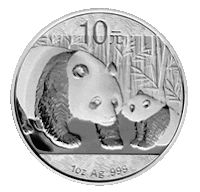 The People’s Bank, which governs the creation of coins in China, has announced that because the Panda coins are so popular they will be increasing production. In December, I wrote that the People’s Bank was plannning on a 10-fold increase in production. However, the recent announcement shows a somewhat smaller increase.
The People’s Bank, which governs the creation of coins in China, has announced that because the Panda coins are so popular they will be increasing production. In December, I wrote that the People’s Bank was plannning on a 10-fold increase in production. However, the recent announcement shows a somewhat smaller increase.
The largest increase will be in the 1⁄10 ounce and 1⁄20 ounce gold Pandas with a 4-fold increase. Silver 1 ounce Panda coins will double from last year. Mintages are being reported as follows:
| 2011 Pandas | 2010 Mintage | New Mintage |
|---|---|---|
| 1 ounce Gold | 300,000 | 500,000 |
| ½ ounce Gold | 120,000 | 200,000 |
| ¼ ounce Gold | 120,000 | 200,000 |
| 1⁄10 ounce Gold | 120,000 | 600,000 |
| 1⁄20 ounce Gold | 120,000 | 600,000 |
| 1 ounce Silver | 3,000,000 | 6,000,000 |
In some forums, it has been suggested that this increase would mark the fourth generation of the silver Panda coins. One source described the generations as:
| Generation | Weight | Content | Size |
|---|---|---|---|
| First Silver Panda Coins (1983-1985) | 27g | .900 fine | 38.6 mm |
| Sterling Silver Panda (1987) one year issue |
1 troy oz | .925 fine | 40 mm |
| Second Generation (1988-1999) | 1 troy oz | .999 fine | 40 mm |
| Third Generation (2000-2010) Change in artists |
1 troy oz | .999 fine | 40 mm |
| Fourth Generation Increased Production |
1 troy oz | .999 fine | 40 mm |
Some have called silver the investment vehicle for the masses. Silver has a silky color that allows for striking designs to be very visible. Because silver is less dense than gold, a one ounce coin made from silver is larger than a one ounce gold coin. This means there is a larger surface area for beautiful designs, like the silver Panda.
Silver Panda coin image and production data courtesy of CGCI


5 Comments